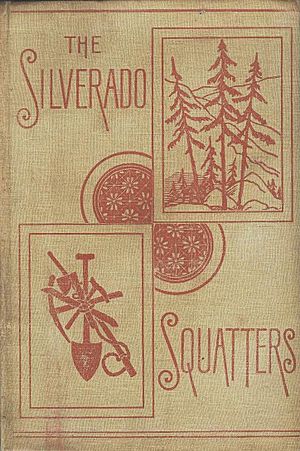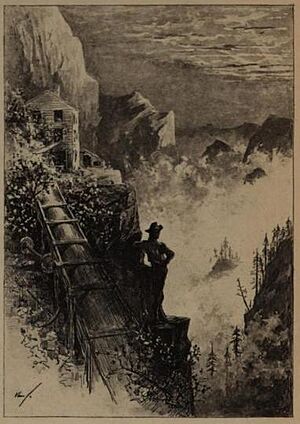The Silverado Squatters facts for kids

2nd U.K. edition 1886
|
|
| Author | Robert Louis Stevenson |
|---|---|
| Country | Scotland |
| Language | English and Scots |
| Genre | Short stories |
| Publisher | Chatto and Windus |
|
Publication date
|
1883 |
| Media type | Print (Hardback) |
The Silverado Squatters (1883) is a travel book by Robert Louis Stevenson. It tells the story of his two-month honeymoon trip in 1880. He traveled with his new wife, Fanny Vandegrift, and her son, Lloyd Osbourne. They explored the Napa Valley in California.
Contents
Why Stevenson Traveled to California
In 1879, Robert Louis Stevenson learned that his future wife, Fanny, was very ill. He quickly left Scotland to be with her in Monterey, California. This journey was difficult for him. He was not doing well financially and was very sick with a lung condition.
Fanny, along with a doctor and nurse, helped him get better. He stayed briefly in Monterey, San Francisco, and Oakland. His father sent him some money. On May 19, 1880, he married Fanny. They had first met in France a few years earlier.
Stevenson was still too weak to travel all the way back to Scotland. Friends suggested they go to Calistoga. It was in the upper Napa Valley. The fresh mountain air there was thought to be good for his health.
An Unusual Honeymoon Stay
The couple first went to the Hot Springs Hotel in Calistoga. But they could not afford the cost. So, they had an unusual honeymoon instead. They stayed in an old, empty building. It was a three-story bunkhouse at a mining camp called "Silverado." This camp was on the side of Mount Saint Helena in the Mayacamas Mountains.
They stayed there for two months during the summer. They put up cloth to cover the windows. They carried water by hand from a nearby stream. They also had to watch out for rattlesnakes. Sometimes, thick fog rolled in, which was bad for Stevenson's health.
What Stevenson Saw in California
The Silverado Squatters shares many details about California in the late 1800s. Stevenson used a telephone for the first time in his life. He met many wine growers in Napa Valley. He thought their wine business was still "experimental." Sometimes, growers even put Spanish labels on their bottles. They did this to sell their wine to Americans who were not sure about local wines.
He visited Jacob Schram, the oldest wine grower in the valley. Schram had been trying new things at his Schramsberg Winery for 18 years. Stevenson also visited a petrified forest. An old Swedish sailor had found it while clearing land. The petrified forest was a source of wonder for everyone.
Stevenson also wrote about meeting a local Jewish merchant. He compared him to a character from a Charles Dickens novel. He described the merchant as happy but always looking for ways to earn money. Like Dickens, Stevenson found it hard to get used to the American habit of spitting on the floor.
How the Book Was Written
Stevenson kept a journal during his time at Silverado. He called it "Silverado Sketches." He used parts of this journal to write Silverado Squatters in 1883. He was living in Bournemouth, England, at the time. Other stories from his journal appeared in "Essays of Travel" and "Across the Plains." Many of his notes about the scenery around him later helped him describe places in his famous book, Treasure Island (1883).
The Legacy of Silverado
Today, the area where the Stevensons stayed is part of the Robert Louis Stevenson State Park. You can find the park entrance at the top of State Route 29. A new trail has been built there in recent years. The Robert Louis Stevenson Museum in St. Helena, California, is dedicated to Stevenson and his works.
Resources and Editions
Editions
- Full text at Project Gutenberg
- The Silverado Squatters (New York: Scribner's, 1923) Limited edition of 380 copies printed by John Henry Nash with portrait and decorated headbands by Howard Whitford Willard
- The Silverado Squatters, audiobook, Blue Pylon Creative (2005). ISBN: 0-9765765-0-3
- The Silverado Squatters, reprint, Tauris Parke Paperbacks (2009). ISBN: 1-84511-990-8
Resources


